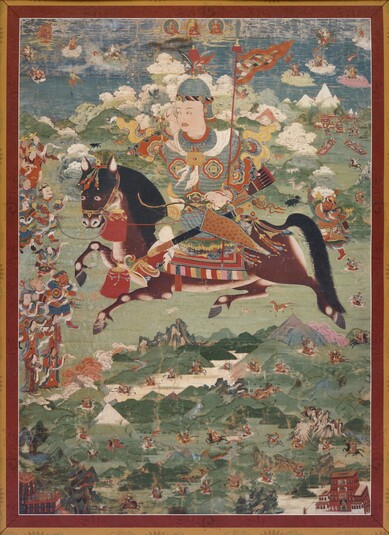
Item: King - Gesar
| Origin Location | Tibet |
|---|---|
| Date Range | 1700 - 1799 |
| Lineages | Buddhist |
| Material | Ground Mineral Pigment on Cotton |
| Collection | Private |
Classification: Person
Appearance: Warrior
Gender: Male
Gesar Norbu Dradul in warrior appearance: from a set of paintings depicting the life story (See the Gesar Main Page).

The Gesar painting (above) with the earliest suggested date is from an image in a Chinese language publication on Tibetan Paintings of the Kham region of Sichuan Province, China. The painting is believed to reside in the Trehor and Kangdze area of Kham. The painting is attributed locally to Trehor Namkha Gyan a famous local artist of the region during the 18th century. His exact dates are still not yet known. What is known is that Namkha Gyan was patronized by the 3rd Panchen Lama, Lobzang Palden Yeshe (1738-1780). This can be learned from official biographies and records.
According to record some of the works of Namkha Gyan were gifted by the 3rd Panchen Lama to the Chinese Emperor where they can be found in the Palace Museum, Beijing, China, even today. It is also believed that numerous paintings created by Namkha Gyan still exist in the Kangdze area as well as in museum and private collections in Sichuan Province and elsewhere.
The Trehor painting depicting Gesar Norbu Dradul allegedly by the artist Namkha Gyan portrays Gesar at the center of the composition looking to the viewer's left. He is greeted by numerous figures of monks, warriors, nobles and noblewomen. The scene is located on a rich green verdant landscape with open plains and mountains behind. Following the figure of Gesar, in a serpentine curve, are the Thirty Hero Warriors each mounted upon a horse and following in a single file originating at the lower left of the composition. This Trehor painting follows very closely the composition of the central painting from the set of eleven compositions belonging to the collection of the Sichuan Provincial Museum, Chengdu.
The Trehor painting, regardless of artist, is similar in three ways to the Sichuan Provincial Museum composition of Gesar. First the (1) posture of the central figure in both compositions is generally the same except mirrored. Secondly, the (2) narrative vignettes are very similar with the congregation of monks, warriors and lay persons greeting Gesar and third the (3) retinue of Thirty Horsemen following behind. Both paintings appear to be telling the same story.
The Trehor painting is most likely from a set of paintings depicting the life story of Gesar and again is most likely the central painting. If this is proven to be so, and if the Trehor painting is in fact created by Namkha Gyan as believed by many, then it would be the earliest currently known painting(s) of Ling Gesar.
Trehor Namkha Gyan, although his exact dates are not known, is one of the most accomplished artists of the 18th century. Numerous works of his are known to exist from Western Sichuan Province to the Imperial Palace in Beijing to possibly as far away as Switzerland. The painting style of Namkha Gyan is a blend of New Menri, Khyenri and local Eastern Tibetan aesthetics of the day. His works were so highly esteemed that they were considered fine enough to be offered as gifts to the Chinese Emperor.
Jeff Watt 11-2011
Bibliography: Specific Subjects
Thematic Sets
King: Gesar Life Story (Literary)
Kings: Tibetan Kings & Ministers (Masterworks)
Painting Tradition: Kandze Valley & Trehor Namka Gyan
King: Gesar Art History
King: Gesar Norbu Dradul
King: Gesar Main Page
King: Gesar (Masterworks)
